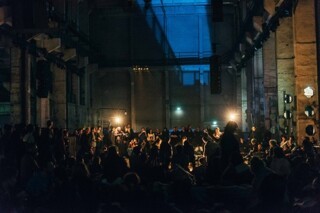At Kraftwerk Berlin
Philip Clark
Kraftwerk Berlin was opened as a performance venue in 2006, in the old Mitte CHP Plant, a power station built in East Berlin in the early 1960s and abandoned in 1997. On a recent Saturday evening, as the time crept towards midnight, I lay on a canvas camp bed in the middle of the turbine hall listening to Alvin Lucier perform his pioneering piece of sound art, I am sitting in a room.
It is a seamless mesh of form and content. Lucier reads aloud his plan to map the acoustic dimensions of the room in which he is sitting – in this case, the Kraftwerk turbine hall – with a recording of his voice; his words are duly recorded, then played back and re-recorded, and so on, the regenerative loop gradually sucking in the resonance of the room. Speech patterns are fragmented and a disembodied tremble of reverberating sound remains. Lucier’s piece is nearly fifty years old but could have been tailormade for The Long Now, the thirty-hour gig curated by Berno Odo Polzer, Laurens von Oswald and Harry Glass, that closes the annual MaerzMusik festival in Berlin.
The Long Now is an invitation to surrender yourself to sound. The end of one piece dovetails into the beginning of the next, until clock time means very little. Morton Feldman said that his music was about a heightened awareness of scale rather than form: ‘Form is easy: just the division of things into part. But scale is another matter.’ It could be The Long Now’s motto. Electronic music, with its capacity to sustain drones and loops, and morph stratified layers of sound indefinitely, can induce trance-like states of altered perception – especially in a place like Kraftwerk Berlin.
Charles Ives, Edgard Varèse and Karlheinz Stockhausen all voiced doubts about the sustainability of concert halls: their radical concepts about dispersing sound through space demanded radical thinking about where that music should be performed. Walk along Köpenicker Strasse for a few blocks, and the decommissioned power station appears like an otherworldly monolith that has been dropped from the sky. Inside, a giant staircase leads, via a network of mezzanine levels, to the main turbine hall. Food is available and the canvas beds are just comfortable enough; but waking up in this alien environment, your slumber disturbed in the dead of night by a wash of electronic sound, is displacing. Your mind plays tricks. It would be easy to lose yourself, you think, to follow a staircase to the top of the building where the abyss below would stare back.
With home comforts stripped away, sound becomes the sole focus of your attention, a way of orienting yourself. The rolling ribbons of arpeggios that Kara-Lis Coverdale teased out of her electronic rig were a balm, a sonic cushion to make up for the lack of pillows on the camp beds. But sound also cut through at a deeper level, directly connecting your senses to the space.
On the Sunday, Lucier’s Vespers plotted the building’s internal dimensions. Musicians moved through the space with gizmos called Sondols, echo-location devices that build an aural picture of rooms and enclosures by bouncing stuttering rhythmic clicks against solid surfaces. After fourteen hours of zoning into sound, I found that my ears were clearly measuring distance by perceiving microscopic differentiations of click – the most distant clicks forming a horizon that framed the manic rhythmic chatter near me.
A two-hour composition by Catherine Christer Hennix, For Brass and Computer, used more intricate divisions of the scale than are customary in Western music as ingredients to build a crescendo, notes passing discreetly between four brass players against a resonant hum from a computer. Bass notes thundered out of speakers the size of tractors. The turbine hall throbbed and shook, reconnecting the space with the ghosts of its industrial past.

